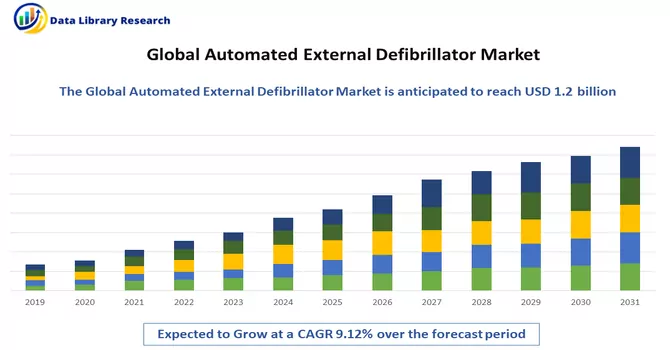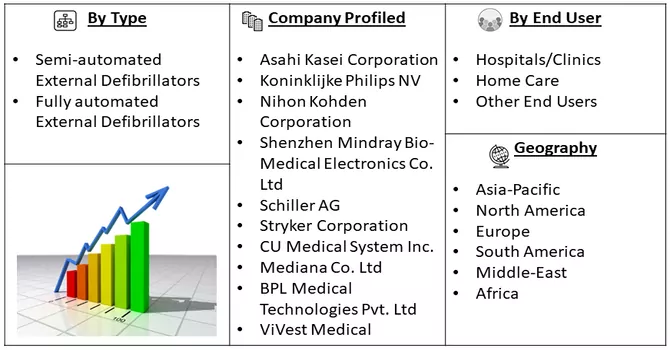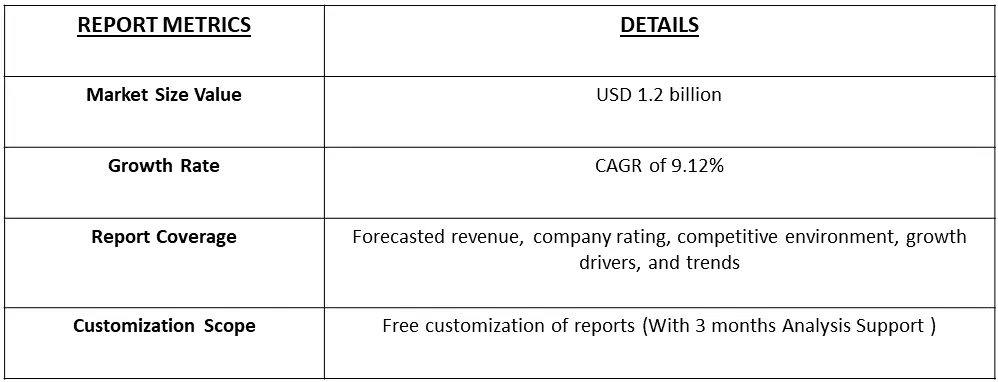The Automated External Defibrillator Market size is estimated at USD 1.2 billion in 2023 and is expected to register a CAGR of 9.12% during the forecast period (2024-2031).

Get Complete Analysis Of The Report - Download Free Sample PDF
A Global Automated External Defibrillator (AED) is a compact and portable medical device designed for the automatic diagnosis and treatment of life-threatening cardiac arrhythmias, particularly during sudden cardiac arrest (SCA). Intended for use by individuals with minimal training, AEDs provide clear voice and visual instructions to guide users through the process of delivering a shock to restore the heart's normal rhythm. The term "global" underscores the widespread availability and deployment of these devices across various settings, including public spaces and healthcare facilities. AEDs play a crucial role in global health by increasing the chances of survival in emergency situations, and efforts to promote their accessibility and public awareness continue to be vital for improving overall cardiac arrest outcomes worldwide.
The Global Automated External Defibrillator (AED) Market is driven by several factors contributing to its growth and widespread adoption. Increasing awareness of the importance of prompt defibrillation in cases of sudden cardiac arrest (SCA) is a significant driver, prompting governments, healthcare organizations, and communities to invest in public access defibrillation programs. The rising incidence of cardiovascular diseases globally, coupled with an aging population, fuels the demand for AEDs in various settings, including public spaces, schools, and workplaces. Technological advancements, such as user-friendly interfaces, connectivity features, and the development of more compact and portable AED models, further enhance market growth. Additionally, regulatory initiatives and guidelines promoting the installation of AEDs in public areas and the continuous efforts to educate the general population on basic life support contribute to the expanding market for these life-saving devices. The growing emphasis on improving emergency response infrastructure globally also plays a pivotal role in fostering the market for AEDs.
Market Segmentation: The Global Automated External Defibrillator (AED) Market is segmented by analysis type (Semi-automated External Defibrillators and Fully automated External Defibrillators), end user (Hospitals/Clinics, Home Care, and Other End Users), and geography (North America, Europe, Asia-Pacific, Middle East and Africa, and South America). The report offers the value (in USD million) for the above segments.

For Detailed Market Segmentation - Download Free Sample PDF
The Global Automated External Defibrillator (AED) Market is experiencing notable trends shaping its trajectory. The integration of artificial intelligence (AI) and smart technologies into AEDs is a prominent trend, enhancing device functionality with features like real-time feedback on CPR quality, remote monitoring, and data analytics. The market is also witnessing a surge in the development of wearable AEDs, providing individuals at risk of cardiac events with continuous monitoring and immediate intervention capabilities. Furthermore, there is an increasing emphasis on AEDs designed for pediatric use, addressing the unique needs of younger patients. Collaborations between AED manufacturers and healthcare organizations are fostering innovations in training programs, simulation technologies, and telemedicine solutions for optimized AED deployment. The market is driven by a growing demand for portable and lightweight AEDs, catering to various settings and facilitating quicker response times during emergencies. Overall, the evolving landscape of the Global AED Market reflects a commitment to advancing technology, enhancing accessibility, and improving outcomes in cardiac emergencies.
Market Drivers:
Rising Prevalence of Cardiovascular Diseases
The rising prevalence of cardiovascular diseases (CVDs) represents a significant global health challenge, with profound implications for public health systems and overall well-being. Cardiovascular diseases encompass a broad spectrum of conditions affecting the heart and blood vessels, including coronary artery disease, heart failure, and stroke. Factors contributing to the increasing prevalence of CVDs include sedentary lifestyles, unhealthy dietary habits, tobacco use, and a growing ageing population. The global burden of CVDs is particularly noteworthy, with these conditions being a leading cause of morbidity and mortality worldwide. As societies undergo demographic transitions and experience urbanization, the prevalence of risk factors such as hypertension and diabetes rises, further amplifying the cardiovascular disease burden. The socio-economic impact of CVDs is substantial, straining healthcare systems and posing challenges for preventive measures and access to cardiovascular care. Efforts to address the rising prevalence of cardiovascular diseases require a multifaceted approach, including public health campaigns, lifestyle interventions, and advancements in medical treatments and technologies to effectively mitigate the impact of these diseases on global health.
Technological Advancements in the Field of Defibrillators
Technological advancements in the field of defibrillators have significantly transformed the landscape of cardiac care, enhancing the effectiveness and accessibility of life-saving interventions. One notable innovation is the integration of smart technologies and artificial intelligence (AI) into defibrillator systems. Modern defibrillators often feature intuitive user interfaces, real-time feedback mechanisms, and adaptive algorithms that optimize their performance in response to varying patient conditions. Connectivity options enable data transmission to healthcare providers, facilitating remote monitoring and timely interventions. Portable automated external defibrillators (AEDs) have become more compact and user-friendly, with voice prompts and visual guides making them accessible to individuals with minimal training. Wearable defibrillator technologies provide continuous cardiac monitoring for at-risk individuals, allowing for immediate response in case of arrhythmias. Moreover, advancements in energy delivery mechanisms and electrode designs contribute to more efficient and targeted defibrillation. The integration of telemedicine capabilities allows healthcare professionals to guide bystanders through the defibrillation process remotely. Overall, these technological strides underscore the commitment to improving outcomes in cardiac emergencies, making defibrillators more effective, user-friendly, and connected within the broader framework of advanced healthcare systems.
Market Restraints:
Lack of Awareness and Early Corrective Measures about Sudden Cardiac Arrest (SAC)
The lack of awareness and early corrective measures regarding Sudden Cardiac Arrest (SCA) poses a significant challenge that may impede the growth of the Automated External Defibrillation (AED) market. SCA is a critical medical emergency, and the effectiveness of AEDs in saving lives is contingent on swift intervention. Insufficient public awareness about the importance of immediate defibrillation and the availability of AEDs in various settings may lead to delays in response times during cardiac emergencies. Educational campaigns and training initiatives aimed at enhancing the knowledge of the general population about SCA and the proper use of AEDs are crucial in addressing this issue. Additionally, the lack of mandatory AED placement and accessibility in public spaces can hinder the timely administration of life-saving measures. Accelerating efforts to raise awareness, promote AED deployment, and educate communities about the significance of early intervention in cases of SCA is essential for fostering the growth and effectiveness of the AED market in contributing to improved cardiac emergency outcomes.
The growth of the automated external defibrillator (AED) market was significantly influenced by the COVID-19 pandemic, primarily due to the postponement of cardiovascular surgeries and a reduction in cardiac surgery volumes caused by stringent government regulations. A study published by the NCBI in July 2021 reported a substantial 52.7% decline in adult cardiac surgery volume in the United States during the first half of 2020. This decrease in cardiac surgeries had a direct impact on the demand for AEDs used in these procedures. However, as cardiac surgical procedures resume in the post-pandemic period, there is an anticipation of a resurgence in the demand for automated external defibrillators. This resumption of normalcy in medical procedures is expected to contribute to the market's growth over the next five years.
Segmental Analysis:
Semi-automated External Defibrillators Segment is Expected to Witness Significant growth Over the Forecast Period
Semi-automated External Defibrillators (SAEDs) represent a crucial advancement in cardiac emergency response technology, offering a user-friendly and partially automated approach to defibrillation. These devices are designed to assist individuals, including those with minimal medical training, in administering life-saving treatment during sudden cardiac arrest (SCA). Unlike fully automated systems, SAEDs typically require the user to initiate the shock delivery after the device analyzes the patient's heart rhythm. SAEDs guide users through the defibrillation process with clear voice prompts and visual instructions, ensuring proper electrode placement and timely intervention. This semi-automated approach strikes a balance between user involvement and automated assistance, making SAEDs accessible in various public spaces, workplaces, and community settings. The portability and intuitive design of these devices contribute to their widespread deployment, emphasizing the importance of rapid response in increasing the chances of survival for individuals experiencing cardiac emergencies. As an integral component of public access defibrillation programs, SAEDs play a vital role in empowering bystanders to become immediate responders and contribute to improved outcomes in cases of sudden cardiac arrest. Thus, such factors are expected to drive the growth of the studied market segment.
Hospitals and Clinics Segment is Expected to Witness Significant Growth Over the Forecast Period
Hospitals and clinics play a pivotal role in the integration and utilization of Automated External Defibrillators (AEDs) as essential components of their emergency response infrastructure. AEDs are critical devices designed to provide immediate assistance during sudden cardiac arrest (SCA), and their strategic placement within healthcare facilities is paramount. In hospital settings, AEDs are often strategically located in high-traffic areas, including corridors, waiting rooms, and emergency departments, to ensure rapid access in case of cardiac emergencies. Clinics, both primary care and specialty facilities, also recognize the importance of having AEDs on-site to address unexpected cardiac events. The accessibility of AEDs in healthcare institutions aligns with the commitment to patient safety and emphasizes the importance of early defibrillation in improving outcomes for individuals experiencing SCA. Healthcare providers undergo training to efficiently operate AEDs, fostering a culture of preparedness and enabling prompt responses to cardiac emergencies within hospital and clinic environments. Additionally, hospitals often contribute to community well-being by participating in public access defibrillation programs, placing AEDs in areas beyond the healthcare facility, such as public spaces, educational institutions, and recreational areas, to enhance the broader community's cardiac emergency response capabilities. Overall, the integration of AEDs within hospitals and clinics underscores the commitment to patient safety and underscores the role these institutions play in advancing public health initiatives related to cardiac care.
North America Region is Expected to Witness Significant Growth Over the Forecast Period
Anticipated growth in the North American automated external defibrillators (AED) market is forecasted, propelled by multiple factors. The region faces a high burden and escalating prevalence of cardiovascular diseases, with the emergence of new product launches and an increasing number of key market players enhancing market dynamics. The expanding geriatric population in North American countries, evident in statistics from August 2022 by Statistics Canada, where the population aged 70 to 74 years was 1,847,585 and 840,545 for those aged 80 to 84 years, is expected to further drive market growth.
The growing awareness campaigns on AEDs, coupled with product approvals and launches, contribute significantly. Notably, initiatives like the Great Western Air Ambulance Charity's CPR and AED usage event and the FDA premarket approval granted to Kestra Medical Technologies, Inc. for the Assure wearable cardioverter defibrillator (WCD) system in August 2021, demonstrate a proactive approach to enhancing AED awareness and accessibility. In light of these factors, the North American AED market is poised for substantial growth over the forecast period.

Get Complete Analysis Of The Report - Download Free Sample PDF
The marketplace for automated external defibrillators (AEDs) exhibits a moderate level of competitiveness, characterized by the involvement of a limited number of major players. Within this sector, a select group of prominent companies plays key roles in shaping market dynamics. These major players are often at the forefront of innovation, research, and development within the AED industry. Their influence extends across manufacturing, distribution, and strategic initiatives that contribute to the ongoing evolution of AED technologies. While competition exists, the market is marked by a balance between these key industry participants, each striving to maintain a competitive edge through product advancements, market expansion, and other strategic endeavors. The moderate competitive landscape underscores the significance of these key players in steering the growth and development of the automated external defibrillator market. Some of the key market players working in this market segment are:
Recent Development:
1) In September 2022, Kauvery Hospital introduced the Restart Heart Foundation, marking a significant initiative in the realm of cardiac care. The foundation unveiled a strategic installation of automated external defibrillators (AEDs), compact and portable life-saving devices specifically designed to provide prompt assistance to individuals facing sudden cardiac arrest. These AEDs feature voice-prompted guidance, ensuring ease of use for immediate responders in emergency situations.
2) In August 2022, the Portage Health Foundation took a proactive step towards enhancing community safety by launching a special grant program dedicated to automated external defibrillators (AEDs). This program aligns with the foundation's overarching sustainability goal of fostering safer communities. By providing one-time grants, the Portage Health Foundation aims to contribute to the long-term well-being of communities by promoting the widespread availability of AEDs, crucial for addressing cardiac emergencies and improving overall public health. These initiatives underscore the growing recognition of the importance of AEDs in healthcare strategies and community safety efforts.
Q1. What was the Automated External Defibrillator Market size in 2023?
As per Data Library Research the Automated External Defibrillator Market size is estimated at USD 1.2 billion in 2023.
Q2. At what CAGR is the Automated External Defibrillator Market projected to grow within the forecast period?
Automated External Defibrillator Market is expected to register a CAGR of 9.12% during the forecast period.
Q3. What are the factors driving the Automated External Defibrillator Market?
Key factors that are driving the growth include the Rising Prevalence of Cardiovascular Diseases and Technological Advancements in the Field of Defibrillators.
Q4. Which Region is expected to hold the highest Market share?
North America region is expected to hold the highest Market share.
Data Library Research are conducted by industry experts who offer insight on industry structure, market segmentations technology assessment and competitive landscape (CL), and penetration, as well as on emerging trends. Their analysis is based on primary interviews (~ 80%) and secondary research (~ 20%) as well as years of professional expertise in their respective industries. Adding to this, by analysing historical trends and current market positions, our analysts predict where the market will be headed for the next five years. Furthermore, the varying trends of segment & categories geographically presented are also studied and the estimated based on the primary & secondary research.
In this particular report from the supply side Data Library Research has conducted primary surveys (interviews) with the key level executives (VP, CEO’s, Marketing Director, Business Development Manager and SOFT) of the companies that active & prominent as well as the midsized organization
FIGURE 1: DLR RESEARH PROCESS

Extensive primary research was conducted to gain a deeper insight of the market and industry performance. The analysis is based on both primary and secondary research as well as years of professional expertise in the respective industries.
In addition to analysing current and historical trends, our analysts predict where the market is headed over the next five years.
It varies by segment for these categories geographically presented in the list of market tables. Speaking about this particular report we have conducted primary surveys (interviews) with the key level executives (VP, CEO’s, Marketing Director, Business Development Manager and many more) of the major players active in the market.
Secondary ResearchSecondary research was mainly used to collect and identify information useful for the extensive, technical, market-oriented, and Friend’s study of the Global Extra Neutral Alcohol. It was also used to obtain key information about major players, market classification and segmentation according to the industry trends, geographical markets, and developments related to the market and technology perspectives. For this study, analysts have gathered information from various credible sources, such as annual reports, sec filings, journals, white papers, SOFT presentations, and company web sites.
Market Size EstimationBoth, top-down and bottom-up approaches were used to estimate and validate the size of the Global market and to estimate the size of various other dependent submarkets in the overall Extra Neutral Alcohol. The key players in the market were identified through secondary research and their market contributions in the respective geographies were determined through primary and secondary research.
Forecast Model
